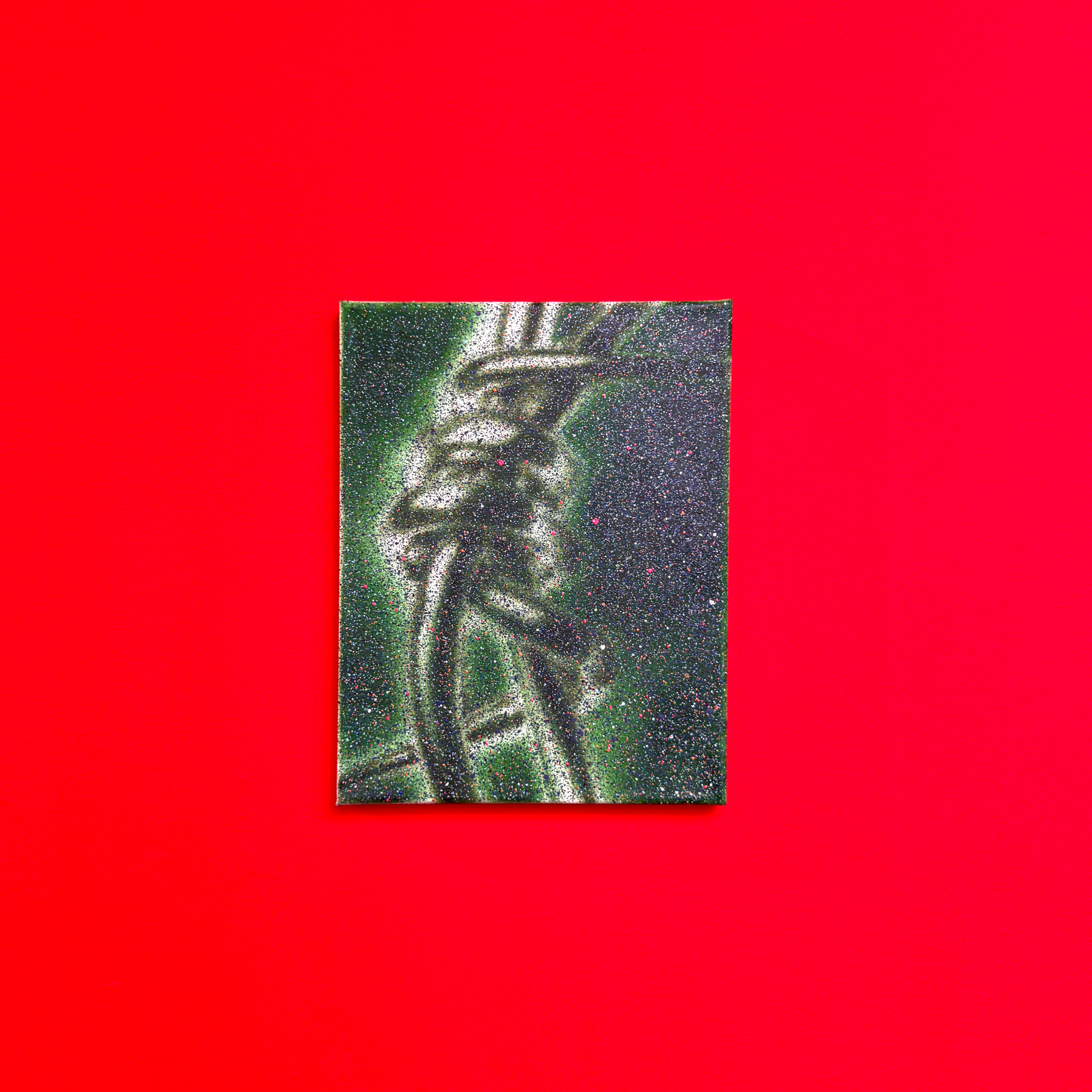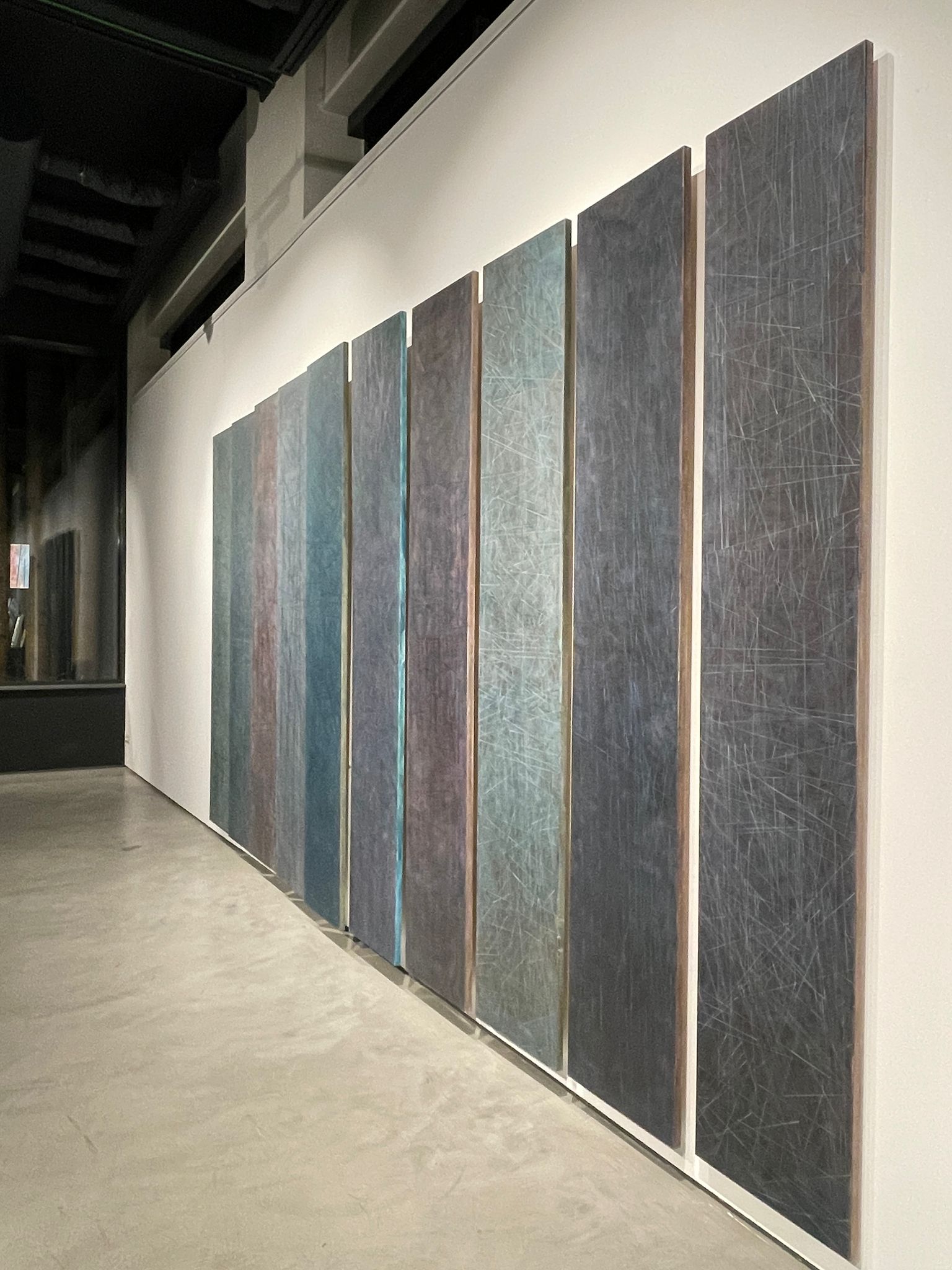Dana Constantin’s artistic activity can be deciphered as a smart strategy for the ‘rehabilitation’ of painting between le faire and la magie, to use Diderot’s well-known phrase. On analysing the fundamental coordinates of her artistic biography, I discovered a coherent course characterised by simplification, profundity and essentialising. The disorder of the natural forms was gradually subjected to purification and concentration on the fundamental means of painting: the dot, the line and the colour (or, more precisely, the surface covered in colours).
What does Dana Constantin propose in her visual series? To me, the answer is obvious: an ex-ercise for the vigilant eye, which can lead to that ‘emission of the eye’ the poet Ștefan Augustin Doinaş wrote about: ‘my gaze is fire and the road/suddenly takes fire/my gaze begs and the ash-es/change back into a road’. For the painter, ‘to render the pure expression of the pictorial space represented by the monochrome, rediscovering the certainty of symmetry/asymmetry in opposition to the unpredictable becoming of the spot’ seems fundamental.
Seen from the perspective of the tension between the figurative and the abstract elements, Dana Constantin’s painting proposes an alternative that rethinks, rediscovers and capitalises on the possibilities of abstract art that dominated the past century, being often regarded as the greatest invention of modernism. The recourse to abstractionism can be read in two keys: as an expression of absolute creative freedom and as ‘escapism’, a privileged form of political non-involvement considered a kind of ‘neutral artistic Esperanto’. That is why an apologia was also necessary: in 1945, Laszlo Moholy-Nagy stated that ‘the intrinsic meaning of an abstract painting, as a peculiar form of visual articulation, lies mainly in the integration of the visual elements, in its freedom from the imitation of nature.’ Dana Constantin explicitly speaks about this liberation from the servitude of imitation when, referring to the ‘phytomorphic mystery’, she declares that her approach no longer follows ‘the direction of imitating nature’, the study of the form and beauty of plants, but ‘the direction of imitating nature’s creative force’, with the desire to express the mystery of apparent simplicity, presenting the final works as monochromes with a profound chromatic register ‘in which the linear vegetal weaving identified with the vital force (or Life) is disclosed’. On reading the artist’s testimony carefully, I cannot help but identify that locus communis which is the justification of any abstract approach: the abolition of the imitation of nature and the exaltation of the pictorial means as such, in the name of the freedom of creation.
The generic title FLOTEs (inspired by the FLOTEs concept – Fundamental Laws of Temporal Evolution – of Tim Maudlin, a philosopher of science, and reformulated/changed into Forms/Light/Opacity/Transparency/Expression) introduces a new stage (started in 2016) in Dana Constantin’s artistic activity, revealing an original dialogue between line and colour, in which the former seems to be the ‘leader’ (as the artist herself confesses), establishing the compositional di-rections and somehow suppressing the superiority of the latter. The monochromes practised so far have been replaced with subtle games of complementary colours that create vibrant shades of col-oured grey. The effect is spectral mirroring suggested by blurry transparencies obtained through the discrete overlapping of the colour layers.
In the FLOTEs cycle, the plastic expression is connected with the concern for the linear, architectural constructions of nature. The plastic synthesis between appearance and essence is mediated by the abstract reflection between the two privileged plastic elements: the Surface and the Line, which derive from the direct observation of the rhythm set by the structures existing in nature.
It is interesting to follow the evolution of the FLOTEs cycle, in which a first moment of radi-calisation is followed by a relaxing moment (FLOTEs II). In FLOTEs I, the artist seems to have experimented a definitive liberation from the physical limitations of the vegetal forms, proposing a new formal linear dimension subordinated to a value register, in a plastic discourse expressed by the quality of the plastic relationships characterized by simplification, profundity and essentialising. In Dana Constantin’s case, as she herself confesses, the essence lies in ‘the formal and architectonic concern with nature’s creative power’. In FLOTEs II, the artist’s journey continues in a manner that surprises only at first sight and is defined by a discrete but definite return to the sinuous, organic, natural line, a more diversified chromatic manner and the fine vertical line (which became a constant feature in Dana’s world of forms), yet preserving the rigour and the essence of the representation.
FLOTEs II is the synthesis of all the form-related concerns that have accompanied Dana Con-stantin in her artistic journey from the purification of the vegetal allusions to the chromatic struc-tures dominated by rigid lines and the recovery of an organic–abstracting-rendering dimension.
Finally, I dare say Dana Constantin’s painting can be regarded (also) as a strategy for the re-covery of ‘pure’ painting (let us not forget that abstract art, as a ‘project of purity’, has always privileged painting) beyond what is in fashion and inevitably remains secondary. I will conclude by evoking Paul Valéry again. In his text about Berthe Morisot, he mentioned l’abstraction de l’artiste, where la couleur lui parle couleur, et il répond à la couleur par la couleur. I believe Dana Constantin has reached this type of abstraction through and for the colour that speaks to her and to which she responds with chromatic compositions that have become the pre-text and the primordial substance of her painting adventure. Following in the footsteps of Valéry, who defined Morisot’s existential dimension through ses grands yeux, very observant of the function of the perpetual act of seeing, I will say that Dana’s eyes, equally wide open, keep looking at reality with concentration, to discover the essence beyond the appearance. Or, to quote the poet Ştefan Augustin Doinaş again: ‘a magical gaze/a radiating eye/a momentary stay/of the magic spell’.
Strata Gallery shows for the first time the whole cycles FLOTEs I-II in a site specific installation, creating a dialogue between paintings and sketches and exposing Dana Constantin’s artistic journey from the initial photographic documentation to the final sublimation of nature in the visual pictorial configurations.
↳ ARTISTS
↳ CURATOR
↳ SCHEDULE
Exhibition open 25.02 - 01.04
Wednesday to Friday from 3pm to 8pm
Weekends by appointment
this

↳ Details
↳ Tags
and that



